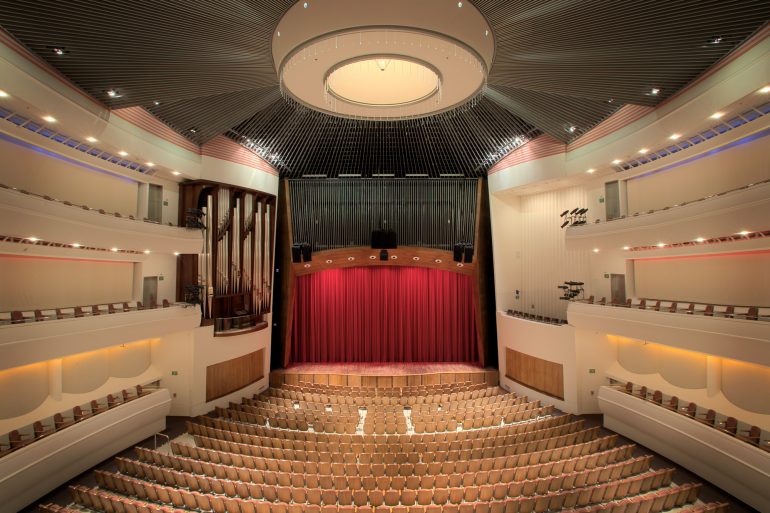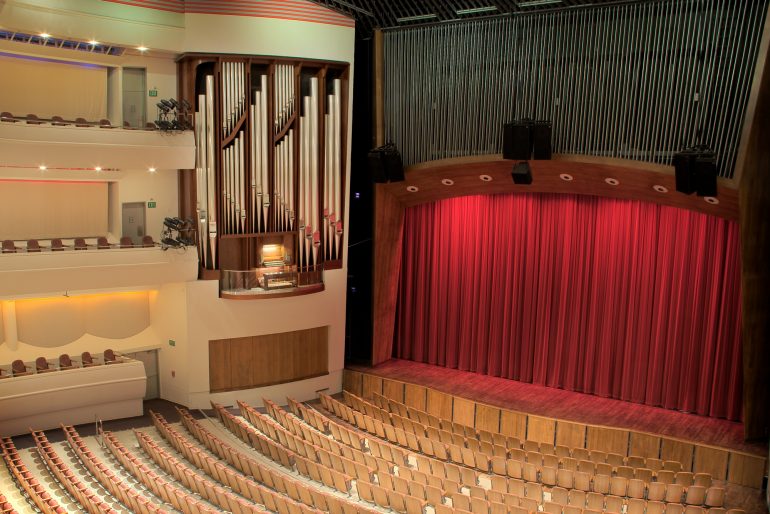
- phone: 978.283.1909
- email: cbfisk@cbfisk.com
Opus 129
Performing Arts Center
San Luis Obispo, CA
Ranks: 48Independent Voices: 38
Pipes: 2767
Created: 2007
In the autumn of 1989 we were approached by the San Luis Obispo Performing Arts Center soliciting our interest in building a new instrument for their proposed concert hall on the campus of California Polytechnic State University. We were subsequently selected as the builder of choice, and worked productively with architect Alberto Bertoldi to ensure that the organ would integrate into the design of the building. Due to unexpected costs in the construction of the building it was twelve years later that the Foundation for the Performing Arts Center signed a contract with us to design and build their new instrument. By then, Harman Hall in the Christopher Cohan Performing Arts Center had been completed and was receiving rave reviews from the international press for its graceful, bold design and its warm, clear acoustics.
The organ owes its existence to the vision and munificence of Bert and Candee Forbes of San Luis Obispo. Thanks to their generous gift to the Foundation, the organ became a reality and the specification was enlarged from two to three manuals. As the visual design evolved, it became clear that larger pipes than 16’ were needed in the visible array, and the Forbes’ additional gift made it possible to place pipes of the 32’ Prestant of burnished tin in the façade—giving the organ the visual and aural impact that a concert hall of this stature deserves.
The organ is housed in a freestanding case built into an elevated niche located just to the left of the proscenium opening. The Great and Pedal divisions were placed just above the main impost level, the Positive over the Great trebles, and the Swell in the location we prefer at the top center of the case. The large Pedal offsets are located at the rear of the case, with the wooden Haskells of the Prestant 32’ just beyond the right case wall. In addition to the burnished tin pipes of the Pedal Prestant 32′, the Great Prestant 16’, and the Positive Prestant 8′ occupy the façade. The largest pipe visible pipe is 32’ GG.
Hidden from sight above the auditorium’s apparent ceiling are two-foot-thick concrete walls and a 400-ton concrete deck. Together they conserve the sound energy of music, speech, and even the organ’s deepest bass sonorities with great efficiency, and they isolate the interior of the concert chamber from exterior noise. In addition, the building’s mechanical systems are flawlessly isolated so as not to intrude on the listening experience, allowing the audience to perceive the finest nuances of speech and music. The acoustical consultants for the hall were Kirkegaard Associates, Lawrence Kirkegaard, Principal, with Edward McCue, Project Acoustician.

GREAT Man I
Prestant 16′ en façade
Octave 8′
Violoncelle 8′
Flûte harmonique 8′
Spillpfeife 8′
Octave 4′
Superoctave 2′
Mixture V-VII
Cornet V (c1–f3)
Trompette 8′
Trommet 8′
Clarion 4′
POSITIVE Man II
Prestant 8′
Gedackt 8′
Principal 4′
Rohrflöte 4′
Nasard 2 2/3′
Doublette 2′
Tierce 1 3/5′
Sharff IV
Cromorne 8′
SWELL Man III, enclosed
Bourdon 16′
Viole de gambe 8′
Voix céleste 8′ (from GG)
Flûte traversière 8′
Dulciane 4′
Flûte octaviante 4′
Octavin 2′
Plein jeu IV
Basson 16′
Trompette 8′
Hautbois 8′
PEDAL
Prestant 32′ ext
Contrebasse 16′
Prestant 16′ Great
Bourdon 16′ Swell
Octave 8′
Violoncelle 8′ Great
Spillpfeife 8′ Great
Superoctave 4′
Contra Posaune 32′ ext
Posaune 16′
Trompette 8′ Great
Trommet 8′ Great
Clarion 4′ Great
Couplers:
Positive to Great
Swell to Great
Octaves graves
Swell to Positive
Great to Pedal
Positive to Pedal
Swell to Pedal
Swell Super to Pedal
Accessories:
Tremulant
Balanced Swell Pedal
Flexible Wind
Crescendo Pedal
Key Action: Direct mechanical (tracker) except for large bass pipes.
Stop Action: Electric solenoid.
Combination Action: 128 levels of memory with appropriate thumb pistons and toe studs.
Kowalyshyn Servo-pneumatic Lever to couplers drawn on the Great
Key Desk: Built into main case of organ, 3 manuals and pedals, manuals 61 notes CC-c4, naturals covered with cowbone, sharps of ebony. Pedals 32 notes CC-g1. Stopknobs positioned in jambs at either side of keyboards, knobs turned of Rosewood.
Casework: A single cabinet of wood located in the organ loft. Façade pipes of polished tine, starting with 32′ GG.




